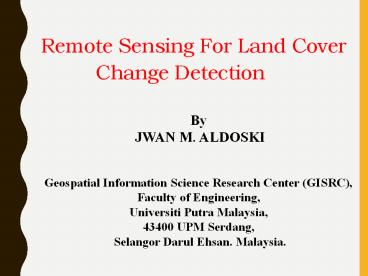Remote Sensing For Land Cover Change Detection - PowerPoint PPT Presentation
Title:
Remote Sensing For Land Cover Change Detection
Description:
Remote Sensing For Land Cover Change Detection – PowerPoint PPT presentation
Number of Views:843
Title: Remote Sensing For Land Cover Change Detection
1
- Remote Sensing For Land Cover Change
Detection
By JWAN M. ALDOSKI Geospatial Information
Science Research Center (GISRC), Faculty of
Engineering, Universiti Putra Malaysia, 43400
UPM Serdang, Selangor Darul Ehsan. Malaysia.
2
Change Detection
- Goal Use remote sensing to detect change on a
landscape over time
3
Change Detection
- Plan for today
- What is change?
- Avoiding uninteresting change
- Methodologies
- Dr. Ripple Examples
4
Change Detection
- To use remote sensing, the change must be
detectable with our instruments - Spectrally
- Distinguish use from cover
- Allow sufficient time between images for changes
to be noticeable - Spatially
- Generally, grain size of change event gtgt pixel
size
5
Change Detection
- Write a list of potential changes that you
think might be interesting to observe with remote
sensing - Any type of remote sensing
- Any period of time over which change occurs
6
Change Detection
- Describing change
- abrupt vs. subtle
- human vs. natural
- real vs. detected
7
Change Detection
- We need to separate interesting change from
uninteresting change
8
Change Detection Uninteresting Change?
- Phenological changes
- Use anniversary date image acquisition
- Sun angle effects
- Radiometrically calibrate
- Use anniversary date image acquisition
- Atmospheric effects
- Radiometrically calibrate
- Geometric
- Ensure highly accurate registration
9
Change Detection Radiometric Calibration
- Minimize atmospheric, view and sun angle effects
- Radiometric normalization
- Histogram equalization or match
- Noise reduction
- Haze reduction
10
Change Detection Radiometric Calibration
- Histogram matching
Pixel Count
Band 4
11
Change Detection Radiometic Calibration
- Regression Approach
12
Change Detection
- Atmospheric correction
- Model atmospheric effects using radiative
transfer models - Aerosols, water vapor, absorptive gases
13
Change Detection Methods
14
Change Detection Methods
- Basic model
- Inputs
- Landsat TM image from Date 1
- Landsat TM image from Date 2
- Potential output
- Map of change vs. no-change
- Map describing the types of change
15
Change Detection Methods
- Display bands from Dates 1 and 2 in different
color guns of display - No-change is greyish
- Change appears as non-grey
- Limited use
- On-screen delineation
- Masking
16
Change Detection Methods
- Image differencing
- Date 1 - Date 2
- No-change 0
- Positive and negative values interpretable
- Pick a threshold for change
- Often uses vegetation index as start point, but
not necessary
17
Image Differencing
Image Date 1
Image Date 2
Difference Image Image 1 - Image 2
18
Change Detection Methods
- Image differencing Pros
- Simple (some say its the most commonly used
method) - Easy to interpret
- Robust
- Cons
- Difference value is absolute, so same value may
have different meaning depending on the starting
class - Requires atmospheric calibration for expectation
of no-change zero
19
Change Detection Methods
- Image Ratioing
- Date 1 / Date 2
- No-change 1
- Values less than and greater than 1 are
interpretable - Pick a threshold for change
20
Change Detection Methods
- Image Ratioing Pros
- Simple
- May mitigate problems with viewing conditions,
esp. sun angle - Cons
- Scales change according to a single date, so same
change on the ground may have different score
depending on direction of change I.e. 50/100
.5, 100/50 2.0
21
Change Detection
Image Difference (TM99 TM88)
Image Ratio (TM99 / TM88)
22
Change Detection Methods
- Change vector analysis
- In n-dimensional spectral space, determine length
and direction of vector between Date 1 and Date 2
Band 4
Band 3
23
Change Detection Methods
- No-change 0 length
- Change direction may be interpretable
- Pick a threshold for change
24
Change Detection Methods
- Change detection Pros
- Conceptually appealing
- Allows designation of the type of change
occurring - Cons
- Requires very accurate radiometric calibration
- Change value is not referenced to a baseline, so
different types of change may have same change
vector
25
Change Detection Methods
- Post-classification (delta classification)
- Classify Date 1 and Date 2 separately, compare
class values on pixel by pixel basis between dates
26
Change Detection Methods
- Post-classification Pros
- Avoids need for strict radiometric calibration
- Favors classification scheme of user
- Designates type of change occurring
- Cons
- Error is multiplicative from two parent maps
- Changes within classes may be interesting
27
Change Detection Methods
- Composite Analysis
- Stack Date 1 and Date 2 and run unsupervised
classification on the whole stack
28
Change Detection Methods
- Composite Analysis Pros
- May extract maximum change variation
- Includes reference for change, so change is
anchored at starting value, unlike change vector
analysis and image differencing - Cons
- May be extremely difficult to interpret classes
29
Change Detection Summary
- Radiometric, geometric calibration critical
- Minimize unwanted sources of change (phenology,
sun angle, etc.) - Differencing is simple and often effective
- Post-classification may have multiplicative error
- Better to have a reference image than not
30
Thank you

